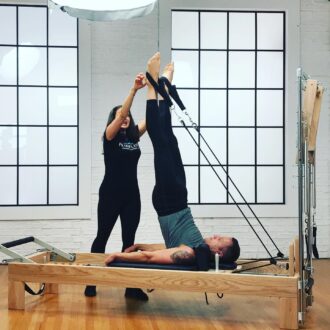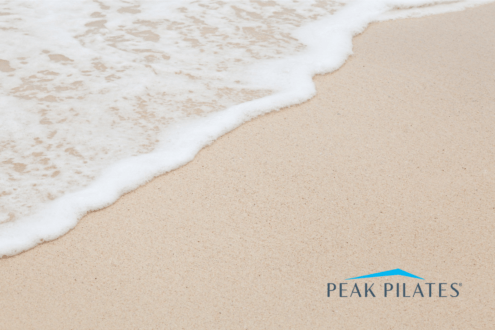By Jamie Isaac
As Pilates teachers we want to share our knowledge, experience and ultimately our passion for the amazing method that we have no doubt fallen in love with. Maybe we’re fresh out of teacher training, or just back from an inspiring conference like PES, or maybe we’ve just taken a workshop and have so many new and inspiring ideas and insights that we just know will 100% help our clients!
That’s why it can be beyond frustrating when we return all lit up and ready to share, but for some reason our students are just not connecting with what we’re sharing. Well, whatever the level of practice your student has, it can be a helpful thought to stop, take a moment and remember the classic line “It’s not you, it’s me.”
No, I don’t mean break up with your student. I mean, if your cue is not getting through, perhaps consider that it’s our responsibility as teachers to refine our communication and a different approach may be the answer.
Here are 5 tip I encourage us to consider when cueing our students…
- Focus on 1 thing at a time
Consider what the most important cue is that you want them to process. This is where we start. It will be different for different levels of practitioner (or those with different movement backgrounds), but layering cue after cue without giving our students time to process it or feel it within their bodies will ensure the movement falls flat. This is especially the case with beginner students or when introducing new exercises with more complicated choreography.
- Layman’s, Not Latin
I get it! Any training course worth its salt included a time investment in deepening our understanding of anatomy. It can be tempting to want to make our students aware of the time we invested, but also to distinguish ourselves from those who maybe didn’t, but in my humble opinion, the real win is to resist the urge and instead show your superpowers by being relatable. Even those with medical degrees may not connect the muscle to the feeling or the direction of the movement to how the body can make it happen. Instead use simple body parts or bones and give them a direction. An example would be encouraging your student to lengthen their spine while seated. A simple direction to reach the top of their head towards the ceiling will have them lifting their spine up from the very bottom vertebrae. For instance: “Shoulder blades into your back pockets,” is far more relatable than “Downwardly rotate scapula in the AC joint using your Latissimus dorsi and Rhomboid minor and major.”
- The Other Left!
We’ve all been there. Mid Chest Expansion and you look left instead of right. Next thing you’re in the dreaded zone of staring directly into another class members eyes like a startled Llama.
To avoid this common moment of terror, simply swap out your rights and lefts with objects such as “Look to the mirror.” The same applies to moving limbs as well. Describing legs as the “nearest” or” top” leg for example will have a group class moving together. I see this a lot when demonstrating or gesturing movement. Are they meant to mirror me, or move the same sided arm? Simply avoid these questions with direct, simple and external cues.
- Stick the Cue Like Glue!
A precise and concise cue that is easy to understand once you have explained its full meaning has the potential to really stick with our students. This makes for a very useful and effective cue that can be used time and time again without any additional explanation or unnecessary words. For example, once we’ve established the concept of what the Powerhouse is and how it feels to engage it, the words “Powerhouse” will have a strong impact, without using too many words.
And this brings me on to my final tip…
- Less Is Often More
This can be relevant for so many aspects of a Pilates practice, but from a teaching perspective I believe this is one of my favs. This tip can apply to both cueing and also our own movement as teachers. How many laps of the studio space do you complete each session? Challenging ourselves to ‘stand and command’ can be a great way to help us be sure we’re teaching from a position where we can be seen or heard well by our students and also embody the posture or concepts that Pilates can bring to our students.
Now let’s consider cueing. I recommend using as few cues as possible to get the movement or execution you are after. Too much verbal or physical cueing can simply become ‘noise’ and overwhelm and confuse our students.
Don’t forget, sometimes it can be okay for the student to feel the incorrect motor pattern and be allowed time to self-correct. If we find the cues we’re sharing aren’t working, we can always take a short teaching moment to better explain the meaning or to give an example of the result we are hoping for.
Consider this with touch cues. Too many in a short space of time makes it harder for our student to process the cue or understand where they should be feeling it, or to react to it. Often one well-considered touch cue can be more effective than one hundred verbal cues. (If our student learns that way.) But we’ll save that discussion for another blog…
So next time that cue doesn’t seem to be landing, or your group class has interpreted your last direction into five unique and very different versions of the exercise you had in mind, why not give one of these points a try. Keeping it simple can often be the way to make even the most complicated exercises accessible and help our students towards effective progress.
Want to learn more? Register for Keep it Simple! Can’t make it live? Recordings will be available!
Keep it Simple – Effective Cues & Building Blocks for Improved Progression – Virtual Workshop
Date + Time: October 08, 2024 from 2:00pm – 4:00pm Eastern
Europe/ Middle East/ Africa: https://peaku.peakpilates.eu/node/6164489?instance=65df50e5eca24a1a00009bdc




